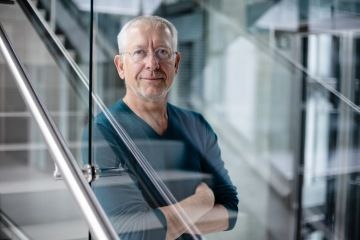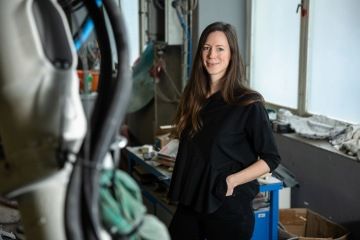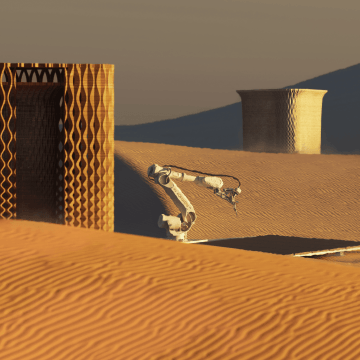
A small workshop complex in Prague’s Holešovice hints at what the future of global construction will most likely become. Here, several robots manage the production of unique artistic objects as well as entire facades and structural components, using sophisticated technology to save time, material, and labor.
Share article
Upon entering the premises of the So Concrete technology company, near the bustling Square in Ortenovo of Prague 7, you are first greeted by a three-meter-high column, whose remarkably intricate concrete texture indicates that it was not made using conventional methods. So Concrete is a pioneer in robotic fabrication technology in the Czech Republic, which in recent years, has been gaining momentum around the world.
As explained by Jana Čepková as she leads a tour of the workshop: “Our journey has already been a long one, and we are continuously developing our materials and production technology. Federico Díaz’s projects and his vision play a significant role in this, showing us that our efforts are worthwhile and that there is a high demand for this technology. Thanks to this, we have experimented with many things and can say we are several steps ahead in this field,”. She points out dozens of mock-ups and prototypes displayed in the courtyard in front of the hall. Among these, visitors can recognize samples from Díaz’s installation at Bořislavka or the panels used for the ventilation shaft from the Blanka tunnel, which are some of the most well-known projects from the So Concrete workshop. The variety of structures, materials, forms, and colors shown by the final products serves as the best demonstration of what the workers, aided by robots, can produce here.
The company is moving far beyond the creation of artistic objects. “Currently, we are also focusing heavily on facades, interior walls, and developing our construction system—essentially a module that can be used to build an entire house,” Čepková reveals, adding that in the first phase, this system is intended for smaller structures like tiny houses, but in the future, could be used for large multi-story buildings.
“The integrated construction system we are developing will include the exterior envelope of the house and the surface of the interior walls, as the individual components already contain insulation. We can produce panels of any shape, up to 2 x 3 meters in size, with various integrated conduits for necessary plumbing, electrical, and media installation, as well as any openings for fixtures. So, from a practical sense no further modifications of these walls are needed on-site,” explains architect and robot programmer Dmitrij Nikitin. So Concrete plans to test this construction system, which allows for almost unlimited shaping and finishing of the structure, on the concierge’s house in Jablonecké in collaboration with the architectural studio Formafatal and on a concrete bunker extension intended for recreational use by a private investor.
The production of concrete components using robots is commonly referred to as 3D concrete printing. However, for So Concrete, this term is an oversimplification, as their technology does much more than just layer material like a standard 3D printer. „It is not just about 3D printing; our robots also work with bending and milling products, adding another dimension, especially aesthetically, and allowing for precise and simple assembly on-site. It is a very complex production system; hence we refer to it as robotic fabrication,“ explains Čepková.
This chemistry is not visible at first glance, but it represents a significant part of our work in material development
This also relates to the materials they use and develop to continuously improve their products. Primarily, they use ultra-high-performance concrete (UHPC), which surpasses regular concrete in its physical and mechanical properties. “UHPC has almost no water seepage; it is virtually waterproof, making it highly resistant to weathering and various chemicals. Its excellent structural and construction properties are also a major advantage. Using this material gives us a significant competitive edge, not just in the Czech Republic, but all across Europe,” explains Nikitin.
The company’s closely guarded technological expertise includes its proprietary concrete formula, developed to achieve material properties best suited for robotic fabrication and specific project types. “We add various wet and dry components in precise ratios to commercially available UHPC. This chemistry is not visible at first glance, but it represents a significant part of our work in material development,” continues Nikitin. “Our machines are precisely calibrated; production depends on the grams of additives. Mixers and pumps essentially have a small computer that specifies what is exactly needed for a particular type of production.”
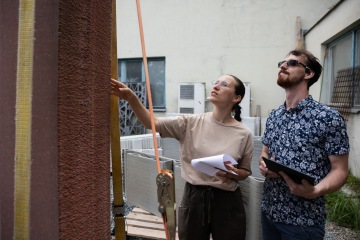
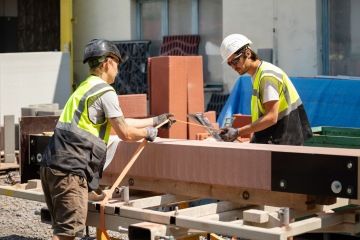
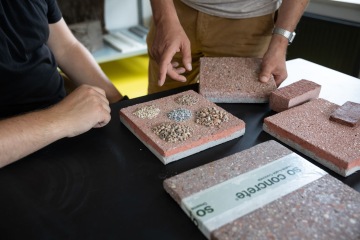
Federico Díaz, the co-founder of So Concrete, has been involved for many years through his artistic projects, and has contributed significantly to material development, which primarily takes place in-house. “He continuously brings new impulses into the process. Sometimes we may look at things too pragmatically, Federico often comes up with ideas beyond conventional boundaries,” notes Nikitin. “We are also currently consulting with Winy Maas from the Dutch studio MVRDV on some projects, and he is also an enthusiast of this technology and material experimentation. We mainly discuss the combination of glass and concrete with him,” reveals Čepková.
In the construction industry of today, the growing emphasis on efficiency, as well as sustainability, has become of paramount concern. Robotic fabrication’s advantage is the precise use of material, resulting in virtually zero waste, a highly desirable benefit in modern construction.
“We constantly seek new ways of reducing the amount of concrete used. It is not just about production efficiency; we can also save a lot of material by optimizing the product design itself. For example, a client came to us with facade panels originally designed to be 12 centimeters thick due to conventional casting methods. Using our technology, we can produce these panels at just 3 centimeters thick. This not only saves material for production and facade mounting but also reduces the building’s weight and thus the required foundation dimensions,” explains Nikitin.
We constantly seek new ways of reducing the amount of concrete used. It is not just about production efficiency; we can also save a lot of material by optimizing the product design itself.
Additionally, the production process can incorporate recycled material, such as ground building rubble. “We are not yet at the stage where we can do this on a large scale, but it is definitely a path we want to pursue,” mentions Dmitrij Nikitin.
Robotic fabrication also allows for on-site production, contributing to a more environmentally friendly construction process. “We are currently negotiating projects in Saudi Arabia, where a new city is being built. They are eager for new technologies, and it would make sense to set up production on-site, transport the robots there, and work with local materials, eliminating the need for complex supply chains,” says Čepková, noting that it is always necessary to consider which type of project makes sense for on-site construction.

The interest from developers, architects, construction companies, and private investors in So Concrete’s products demonstrates the high demand, and their production hall is already nearing capacity limits. Production is incredibly fast, with robotic arms currently “printing” at a speed of 40 centimeters per second. “We can go even faster; it is primarily a matter of optimizing the production process at this point,” says Dmitrij Nikitin, observing one of the robots in action. A brand-new system is being installed. “This robot, on which my colleague is installing a new print head, has a linear track mechanism underneath, allowing for a larger production area.”
The company still deals with a number of misunderstandings and prejudices, an inevitable part of introducing new technology. “We believe that robotic fabrication will become a standard method of production and construction in the future, thanks to the advantages it brings to the process. There is no reason why we should not use this technology on a larger scale today. We are not doing anything sci-fi here; it is a reality that does not need to be feared,” concludes Dmitrij Nikitin.
Share article
More news
So Concrete at Timber Square: Concrete meets low-carbon innovation in the heart of London
We’re proud to be part of Timber Square, Landsec’s landmark sustainable development in the heart of Bankside, London. Here we’ve created a set of high-performance concrete (HPC) elements, including four large-scale planters for trees and a multi-functional planter-bench system that helps shape the public realm.
The Construction Industry Needs Innovation
Ladislav Bartoníček’s journey to So Concrete was driven by his passion for art and a long-standing friendship with artist Federico Díaz. What motivated this prominent figure from the PPF Group to invest in the company and contribute to its further development?
Process for Digital Concrete
Façade tiles, columns, interior accessories, wall cladding, as well as entire buildings - all of this is produced by So Concrete using robotic fabrication for clients from the ranks of developers, architects, construction companies or private investors.
Share article
More news
So Concrete at Timber Square: Concrete meets low-carbon innovation in the heart of London
We’re proud to be part of Timber Square, Landsec’s landmark sustainable development in the heart of Bankside, London. Here we’ve created a set of high-performance concrete (HPC) elements, including four large-scale planters for trees and a multi-functional planter-bench system that helps shape the public realm.
The Construction Industry Needs Innovation
Ladislav Bartoníček’s journey to So Concrete was driven by his passion for art and a long-standing friendship with artist Federico Díaz. What motivated this prominent figure from the PPF Group to invest in the company and contribute to its further development?
Process for Digital Concrete
Façade tiles, columns, interior accessories, wall cladding, as well as entire buildings - all of this is produced by So Concrete using robotic fabrication for clients from the ranks of developers, architects, construction companies or private investors.

